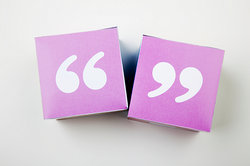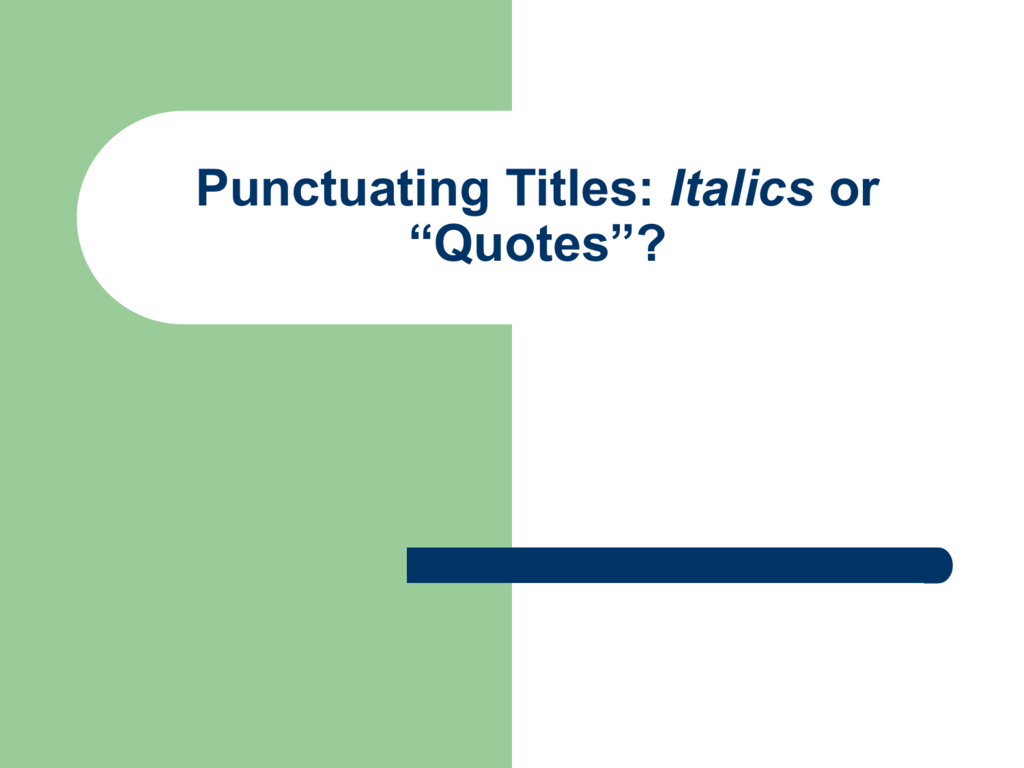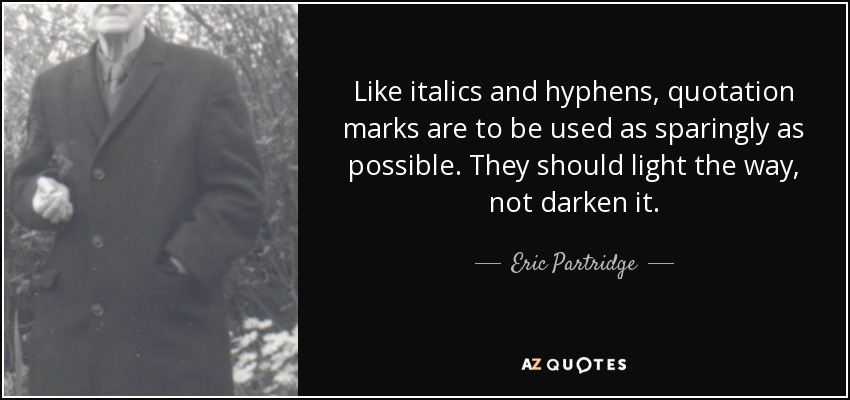Articles
Quotes Vs Italics
- Side-by-side comparison from regular, to bold, to italic, to bold-italic: Text Text Text Text When to use italic vs. One school of thought is that since italic and bold are both used to emphasize certain parts of a text block, you should only use one of them, at least within the same text block.
- Works That Require Quotation Marks. Album tracks or singles (“Blackbird” from The White Album) Book chapters (“The Boy Who Lived” from Harry Potter and the Sorcerer’s Stone) Podcast episodes (“The Alibi” from Serial) Poems (“The Road Not Taken”) Short stories (“The Tell-Tale Heart”) Speeches (“I.
Do you know when to use quotation marks? How about single quotation marks?
Learn how to use italics, underlines, and quotes when writing titles of books, movies, songs, etc. If you're seeing this message, it means we're having trouble loading external resources on our website. If you're behind a web filter, please make sure that the domains.kastatic.org and.kasandbox.org are unblocked. As this post states, “You may also use italics without quotation marks for direct internal dialogue.” Either quotes or italics can be used. We would not say that one is more acceptable than the other. As an author it is up to you to decide which one to use. If you feel that italics makes your sentence less “confusing,” you can use italics. You can still use underlining, yes, but it is now more acceptable to use italics in it’s place if you are doing typed writing. If you are stuck deciding which of the two to use (and you’re typing), use italics. So again, BIG things get italicized (or underlined); small things get quotes. I hope this helps!
Are Chart Names In Quotes Or Italics

How to Use Single Quotation Marks
Today's topic is single quotation marks versus double quotation marks.
How to Use Double Quotation Marks

Most people think of double quotation marks as being for quotations, which they are, but they also have other legitimate uses. For example, double quotation marks are often used around the title of a short work such as a magazine article or an episode of a TV show.
The 'Darmok' episode of 'Star Trek: The Next Generation' is one of my favorites.
The rules for longer works, such as books, are tricky. The Associated Press uses quotation marks, but the Chicago Manual of Style and the MLA Handbook recommend italics.
Here are some of the more common situations where people use double quotation marks:
Buy Now
- Use double quotation marks for scare quotes
- Use double quotation marks for words used as examples
Let's talk more about these examples below.
Use Double Quotation Marks for Scare Quotes
People also sometimes use double quotation marks to indicate that a word is special in some way. I bet you've all seen quotation marks used as something called scare quotes, which are quotation marks put around a word to show that the writer doesn't buy into the meaning. For example, I could write the sentence:
Women achieved “equality” when they were granted the right to vote in 1920.
That would indicate that although women getting the right to vote was heralded as equality at the time, I don't think it was enough of a gain to merit the word “equality.” More often though, scare quotes (which are also sometimes called sneer quotes) are used to impart a sense of irony or disdain. They're especially common in nasty political commentary, as in Politicians “care” about their constituents.*
Use Double Quotation Marks for Words Used as Examples
Double quotation marks can also be used when you are writing a sentence and you want to refer to a word rather than use its meaning. Since I talk about words a lot, this comes up in almost every Grammar Girl episode. It's a style choice. You can use italics or double quotation marks to highlight words, but we use quotation marks on the Grammar Girl site.
Be Careful of Unnecessary Quotation Marks
A common mistake, though, is to use quotation marks to simply highlight a word in a sentence. The popular “Blog” of “Unnecessary” Quotation Marks (rest in peace) did nothing but mock signs that misuse quotation marks in this way. For example, if you are promoting your gluten-free cookies, and you put “gluten-free” in quotation marks, that actually means they have gluten. Stick with underlining or italics, or bold to highlight words.
Why Use Single Quotation Marks?
Here are some of the most common reasons people use single quotation marks:
- Use single quotation marks for a quotation within a quotation
- Use single quotation marks in headlines
- Use single quotation marks for words not being used for their meaning
Let's talk more about each of these situations.
Use Single Quotation Marks for a Quotation Within a Quotation
The most common reason to use single quotation marks is to quote someone who is quoting someone else. The rules are different in British English, but in American English, you enclose the primary speaker's comments in double quotation marks, and then you enclose the thing they are quoting in single quotation marks. You nest them, with the double quotation marks on the outside and the single quotation marks on the inside.
For example, imagine you've interviewed Aardvark for a magazine article about his harrowing ordeal with an arrow, and he said, “Squiggly saved my life when he yelled, 'Watch out, Aardvark.' ”
If you're ever in the extremely rare position of having to nest another quotation inside a sentence like that, you would use double quotation marks again for the third nested quotation.
You can find many articles that say British English uses single quotation marks around a direct quotation instead of double quotation marks, and although doing so is more common in British English than in American English, it doesn’t seem to be a hard-and-fast rule. I found many British news sites that used double quotation marks just like an American site would, including The Guardian, The Sunday Times, The Sun, and the BBC. It seems like using single quotation marks is more of an option in British English than a prevailing style. And in Britain, they also sometimes call them inverted commas.
Use a Thin Space Between a Single Quotation Mark and a Double Quotation Mark
It can be hard to see a single quotation mark that’s followed by a double quotation mark when they fall right next to each other like they did in the last example, so typesetters sometimes insert something called a thin space between the two quotation marks. A thin space is just what it sounds like: a space that’s thinner than a regular space.
@GrammarGirl Very useful post. Re: Thin Space; its Unicode codepoint is U+2009. Example; with ' ', and without '. — Shervin Afshar (@shervinafshar) June 19, 2013
Use Single Quotation Marks in Headlines
Another place you’ll see single quotation marks a lot is in headlines in newspapers and on websites because the Associated Press uses single quotation marks for quotations in headlines.
Use Single Quotation Marks to Highlight Words Not Being Used for Their Meaning
Finally, it’s the convention in certain disciplines such as philosophy, theology, and linguistics to highlight words with special meaning by using single quotation marks instead of double quotation marks.


'Quote' Versus 'Quotation'
Also, a frequent point of confusion is the difference between the words “quote” and “quotation.” “Quote” is a verb that means to repeat what someone else has said or written. For example, 'Aardvark quoted Squiggly.' “Quotation” is a noun used to describe what you are quoting, as in 'Squiggly's quotation was inspiring.'
It's common to hear people use the noun “quote” as a shortened form of “quotation,” as in 'I filled my notebook with quotes from 'The Daily Show,' but that is technically wrong. It should be, 'I filled my notebook with quotations from 'The Daily Show.'
Quotation Vs Italics
I agree the correct way sounds a bit pretentious, and given that a lot of reference sources have extra entries discussing how the misuse is widespread, you aren't going to sound illiterate if you use “quote” incorrectly, but it is still good to know the difference.
Summary
In American English, use double quotation marks to surround a quotation. In British English, you can use single or double quotation marks for that. If you write for a company or publication, check your style guide. If you need to put a quotation inside your first quotation, use the opposite type of quotation marks to surround it. That’s single quotation marks in American English.
Double quotation marks can also be used to show sarcasm or to identify words used as words instead of for their meaning. Single quotation marks are often used in headlines and in some disciplines to highlight words with special meanings.
Quotes Vs Italics For Emphasis
*Normally I would put this sentence in quotation marks, but I wanted to reserve them to make the point that the word is meant to be facetious, so I chose to emphasize the sentence with italics.